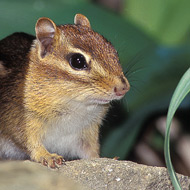Critters can cause damage to your yard Holey mess

By Marilyn McKinley
OSU Master Gardener Volunteer
You are strolling through the yard or mowing and you notice a hole.
What creature is lurking below? What might crawl in or out of that hole?
It could be a mole, a vole, a chipmunk, a snake, bees or a groundhog. What do you do?
Let’s take a look at what each hole looks like and what damage may ensue.
A mole hole
These little creepy carnivores are looking for earthworms and grubs. The hole looks like cone-shaped mounds of soil. This is where the mole surfaced after excavating a network of tunnels. The opening is 2 inches wide.
The mole does not eat roots but can do some unsightly damage above ground by uprooting turf and plants. One upside: If you have moles, you probably don’t have as much clay in your soil as you might think. Traps are the most effective way to get them. By eliminating grubs in your yard, they might decide to look elsewhere.
A groundhog hole
Strong teeth and claws make groundhogs excellent diggers. The main-entry hole, or burrow, is at least 10 inches wide with soil spread around the opening. There are likely to be other openings at a foundation of a house or shed.
These critters move hundreds of pounds of soil, which can compromise the stability of structures and trees, while damaging roots. Groundhogs consume turf and vegetables. They also chew wood. Filling in the hole is useless. You might try putting moth balls into the hole. The best thing to do: Trap it!
A chipmunk hole
They dig a nesting hole that leads to long, elaborate tunnels. They can carry soil in their cheeks and deposit it elsewhere, so there may not be loose soil around the hole. Holes are about 2 inches wide and are usually spotted along a walk or pathway. Chipmunks dig in the yard and will dig up and eat bulbs, earthworms, berries and seeds. How to get rid of them? The most-effective way is to trap them.
A vole hole
The hole often will be hidden in mulch or ground covers. They are about 11/2 inches wide, about the diameter of a golf ball. Worn pathways of 1 to 2 inches across may lead to an opening, and is easily disguised by tall turf or weeds. Voles are viscous. They wear away at the lawn, eat tender bark, young stems, roots, bulbs, seeds and flowers. They will eat food equal to their weight daily. How to get rid of them? Bait as you would mice, and keep weeds pulled, turf trimmed and debris gathered.
Snakes
Snakes use holes of rodents. They do not dig their own. They like cool, dark places near water. Keep debris down to decrease your chances of snakes in your yard.
Bees
Their nests resemble an anthill with a larger opening. Learn the difference between a wasp and a bee. Ground bees are not usually aggressive. Wasps, however, are ready to attack.
 43
43
